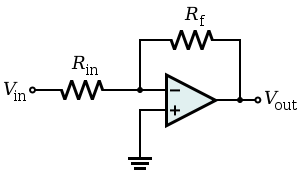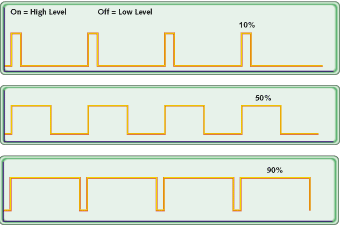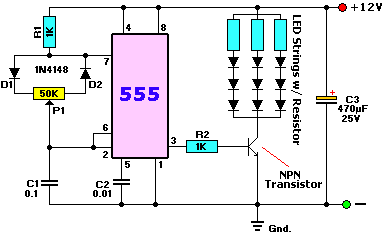Because of my workload, I do not have too much time to spend at the forum. I just wanted to give you an update of the experiments I am performing. I will continue running more tests for the following two weeks. I have not yet tested the secondary coil with a load. First, I want to maximize the design of the primary circuit.
Please, refer to the following link for the images: ImageShack Album - 7 images
IMAGE No. 1:
Shows the setup that I am using: the Arduino controller, the breadboard with the driver, the seven resistors (200 ohms each), and the primary and secondary coils.
IMAGE No. 2:
Shows two 50Ω/50W resistors used as dummy loads to replace the primary coils.
IMAGE No. 3:
Shows the output voltages dropped across the two 50Ω/50W dummy resistors replacing the primary coils. Each scope probe is set at x10. Notice that the small voltage steps are followed by a large jump in voltage. The frequency of the voltages is about 68Hz
IMAGE No. 4:
Shows the setup of IMAGE #3 but with seven 10 ohms resistors instead of the 200Ω. The scope probes are set at x1. Notice that the voltage steps are better defined.
This is an important design criterion to be applied when using the resistors as shown in the patent. The value of the resistors must be optimized for the impedances of the primary coils. If the resistors are too high the voltage steps are small and large at positions 1 and 8 as shown in image 3. On the other hand, if the resistors are too small, the DC component of the primary current would be too high, which increases the primary current considerably.
IMAGE No. 5:
Shows the setup of IMAGE #4 but with the primary coils connected instead of the dummy resistors. No load is connected at the secondary coil. There is no DC voltage component at the coils, as expected. The controller and the driver are working fine because there are no voltage spikes. The transitions of the power transistors are make-before-break. The scope probes are set at x10.
When the loads are pure resistive as in IMAGE #4, the minimum and maximum values of the voltages occur when the transistors at positions 1 and 8 are on. When the primary coils are connected, the minimum voltage value occur at about positions 3 and 5.
IMAGE No. 6:
The top graph corresponds to the voltage drop across a primary coil with no DC component. The scope probe is set at x10. The bottom graph represents the current flowing through the same coil and corresponds to the voltage drop across the 0.25 Ohms resistor used as a shunt resistor. There is a DC component. The first x-axis from the bottom corresponds to zero voltage. The scope probe is set at x1. A design goal should be to minimize the DC component applied to the primary coils. Notice that even though the voltage applied to the coil changes in steps, the changes of the current through the coil is smooth. As expected, the current in an inductor cannot change instantaneously.
I am giving you some test bench information that can be helpful for constructing the model.
Wonju-Bajac
PS: this will be my last reference to the issue of the resistors being used as a current splitter and/or the phase shift of the primaries. I just wanted to provide an analysis of a current splitter using six (6) resistors as shown in image 7. The results of the calculations indicate that the sum of the two currents is not always a constant when using resistor loads. But, with the primary inductor coils, it could be a different story.
Please, refer to the following link for the images: ImageShack Album - 7 images
IMAGE No. 1:
Shows the setup that I am using: the Arduino controller, the breadboard with the driver, the seven resistors (200 ohms each), and the primary and secondary coils.
IMAGE No. 2:
Shows two 50Ω/50W resistors used as dummy loads to replace the primary coils.
IMAGE No. 3:
Shows the output voltages dropped across the two 50Ω/50W dummy resistors replacing the primary coils. Each scope probe is set at x10. Notice that the small voltage steps are followed by a large jump in voltage. The frequency of the voltages is about 68Hz
IMAGE No. 4:
Shows the setup of IMAGE #3 but with seven 10 ohms resistors instead of the 200Ω. The scope probes are set at x1. Notice that the voltage steps are better defined.
This is an important design criterion to be applied when using the resistors as shown in the patent. The value of the resistors must be optimized for the impedances of the primary coils. If the resistors are too high the voltage steps are small and large at positions 1 and 8 as shown in image 3. On the other hand, if the resistors are too small, the DC component of the primary current would be too high, which increases the primary current considerably.
IMAGE No. 5:
Shows the setup of IMAGE #4 but with the primary coils connected instead of the dummy resistors. No load is connected at the secondary coil. There is no DC voltage component at the coils, as expected. The controller and the driver are working fine because there are no voltage spikes. The transitions of the power transistors are make-before-break. The scope probes are set at x10.
When the loads are pure resistive as in IMAGE #4, the minimum and maximum values of the voltages occur when the transistors at positions 1 and 8 are on. When the primary coils are connected, the minimum voltage value occur at about positions 3 and 5.
IMAGE No. 6:
The top graph corresponds to the voltage drop across a primary coil with no DC component. The scope probe is set at x10. The bottom graph represents the current flowing through the same coil and corresponds to the voltage drop across the 0.25 Ohms resistor used as a shunt resistor. There is a DC component. The first x-axis from the bottom corresponds to zero voltage. The scope probe is set at x1. A design goal should be to minimize the DC component applied to the primary coils. Notice that even though the voltage applied to the coil changes in steps, the changes of the current through the coil is smooth. As expected, the current in an inductor cannot change instantaneously.
I am giving you some test bench information that can be helpful for constructing the model.
Wonju-Bajac
PS: this will be my last reference to the issue of the resistors being used as a current splitter and/or the phase shift of the primaries. I just wanted to provide an analysis of a current splitter using six (6) resistors as shown in image 7. The results of the calculations indicate that the sum of the two currents is not always a constant when using resistor loads. But, with the primary inductor coils, it could be a different story.













Comment